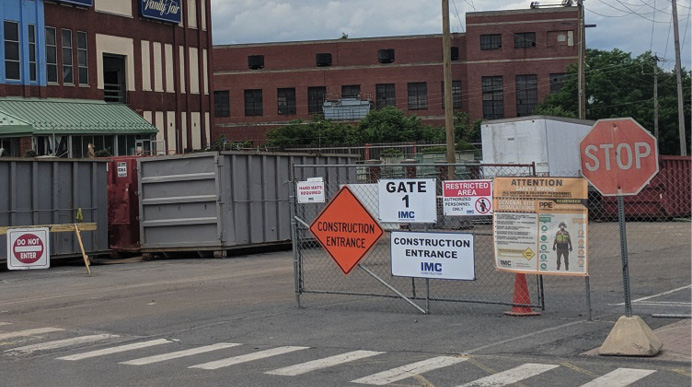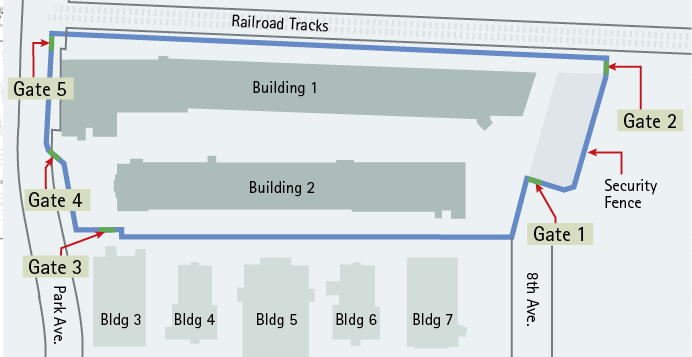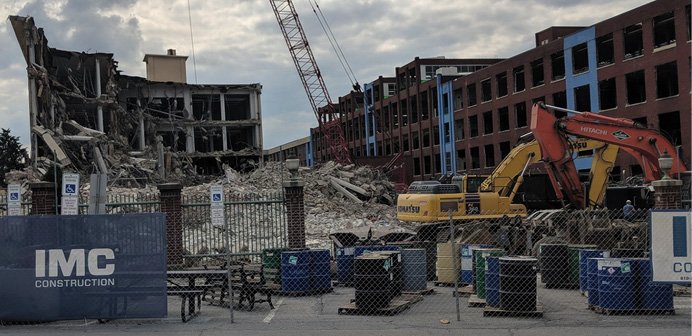
TRAINING NOTEBOOK ❘ BY BRANDON D. EPTING
Many fire departments perform some level of inspection and preplanning for existing commercial buildings and new construction. Response preplanning is just as critical during the demolition of large or multistory buildings and complexes. Demolition sites are constantly changing; preplans from the prior occupancy quickly become obsolete. You must inspect these periodically and update your preplans to maintain your response readiness.
Access Changes
During demolition, property access could change. The usual entrances, exits, and parking lots may be closed off with temporary fencing and gates (Figure 1, photo 1). Fire apparatus may have to navigate around roll-off dumpsters, stationary crushing machinery, and rubble piles that are not easily moved. The site security personnel during demolition may not be the same ones who were there during the previous occupancy. They may be unfamiliar with the fire alarms, standpipe/sprinkler systems, and other utility controls (gas and electric).
RELATED FIREFIGHTER TRAINING
Main Street USA: Preplanning Your First-Due Response
The Useful Opposition of Preplanning and Premortems
Preplanning for Fires in Self-Storage Warehouses
Figure 1. Updated Site Plan with New Temporary Access Gates

Figure courtesy of author.
Fire Alarm Systems
Automatic fire alarm systems will cause some issues during a major demolition project. Don’t let recurring false alarms lead to complacency. Depending on the building’s size, the fire alarm panel may be relocated to maintain protection of structures that will not be torn down. During the project shown in the photos, a fire alarm panel was moved from a former security office in one building to a basement closet in a building across the street. If, on inspection, building demolition supervisors inform you that the fire panel location may change during the overall demolition process, a good forethought may be to always meet the security personnel at a set location so they can escort fire department units to the fire panel location. If a fire does occur, contractors will often attempt to extinguish the fire themselves before notifying emergency services. The delayed alarm gives the fire an opportunity to progress.

(1) Photos by author.

(2)
Water Supply
An adequate water supply is vital to extinguishing fire. But the nearest hydrant may be out of service or blocked by equipment. Contractors may have valves or manifolds connected to the hydrant and operate a hoseline from it to spray down the dust created during the demolition. Having to remove contractor appliances from hydrants could delay establishing a water supply for firefighting.
Anticipate water supply issues. You might need large-diameter hose to get water into the scene. You may need to stretch an alley line (an extended lay of three-inch hose with a gated wye) for handlines to reach areas that the apparatus can’t access.
New Hazards
Building demolition introduces many new hazards to site workers and emergency responders. Gas service lines may be inadvertently damaged; they are often larger than a residential home service line because of the size of the structure.
Dismantling electrical systems can result in shock, burn injuries, or fires. Even a routine medical call could require a patient extrication from the upper floors if elevators are inoperable. Will this require a tower ladder and stokes basket removal or a high-angle rescue?
Collapse Dangers
Walls and other structural elements can collapse unexpectedly; is your department trained for a building collapse rescue? Do you have additional resources identified if a collapse with people trapped occurs? Whenever you are at a demolition site, be vigilant of all structural integrity. Heavy construction equipment or fire apparatus operation may affect building stability; machinery in close proximity to a specific rescue operation may need to be shut down. The demolition site in photo 2 illustrates several common hazards and obstacles. Walls that are no longer supported could collapse. Large piles of rubble, fencing, cranes, and excavators restrict firefighter access. What is in the steel drums and what hazards do they present?
Hazardous Materials
At demolition sites, expect hazardous materials to be present that weren’t there before—e.g., acetylene for cutting torches and bulk diesel fuel and hydraulic fluid for heavy machinery. Who knows what you might encounter in a dumpster fire? Use the reach of your stream or an apparatus deck gun for safety.
Always require that personnel wear eye protection and helmets when operating at these sites, especially with the hazards of flying dust and items that could become airborne. Ensure that the personal protective equipment meets the safety standards for the tactic you are performing. Assume all older buildings contain asbestos, and consider on-site decontamination of all fire department personnel exposed to dust or products of combustion.
This is not an exhaustive list of considerations at demolition sites. Each project and jurisdiction will have unique factors. Think and become more engaged in the next demolition project in your response area. Remember, the information you gather is only useful if you communicate it to all your personnel and mutual-aid companies who could potentially respond.
BRANDON D. EPTING is a firefighter/emergency medical technician with the Denver Fire Company in Lancaster County, Pennsylvania.

